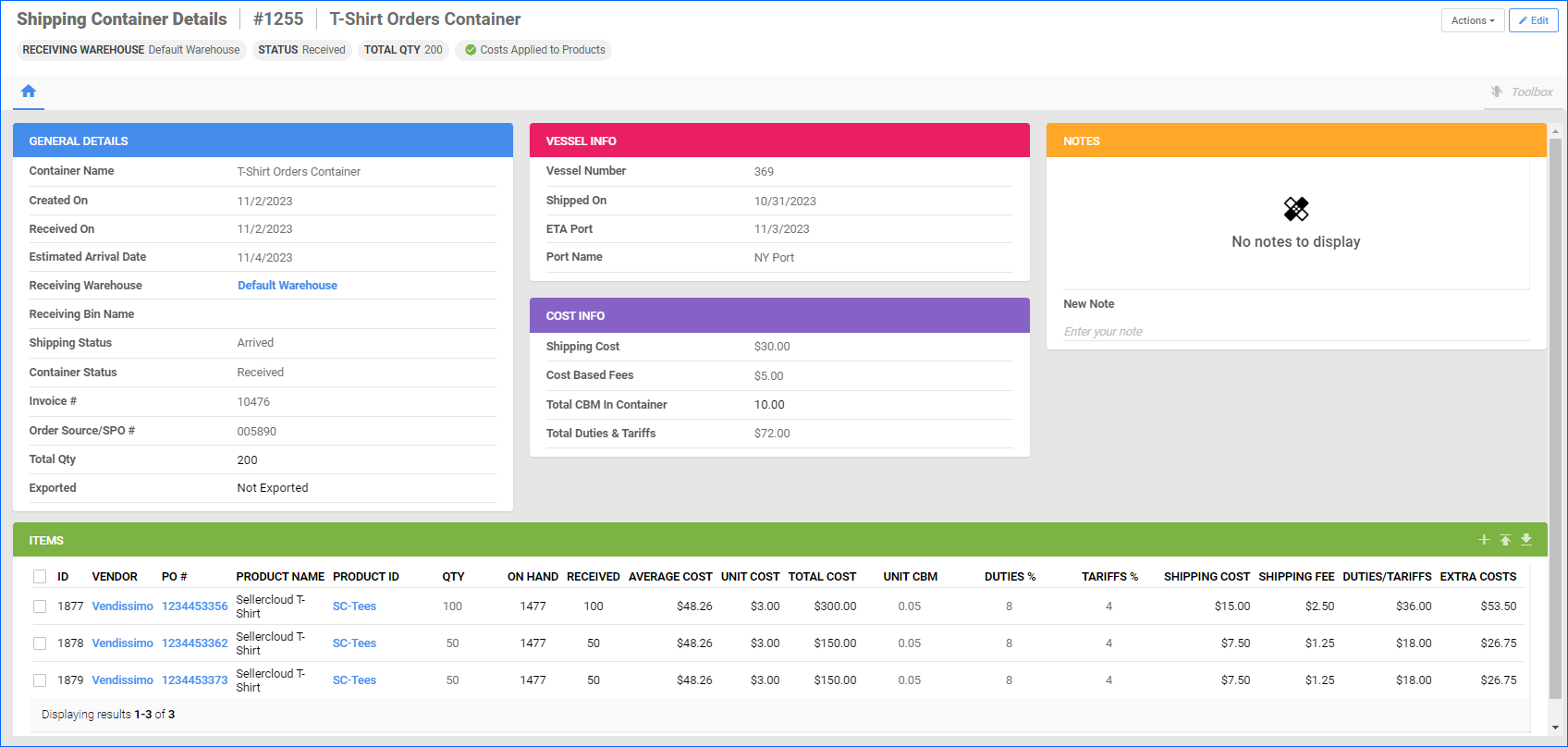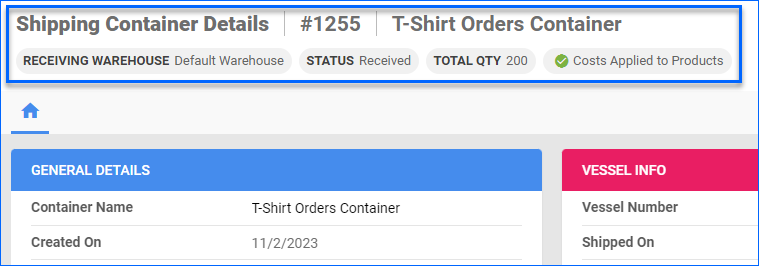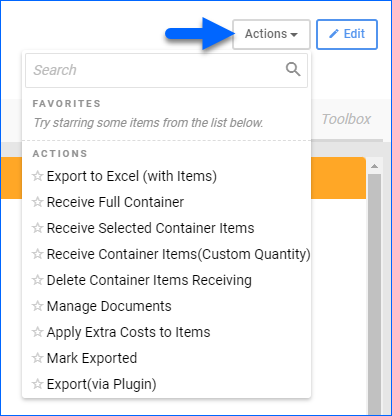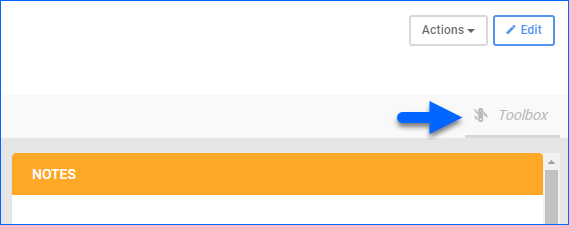Overview
Each Shipping Container in Sellercloud has its own Shipping Container Details Page, where you can access and update any related information and settings. In this article, you will learn about all available options on the page. This includes the different panels, the Toolbox tabs, and the Actions you can perform on your shipping containers.
Shipping Container Details
To access the Shipping Container Details page:
- Go to Purchasing > Shipping Containers.
- Click Search to see all containers. Optionally, you can use the filters to control which containers appear in the search results.
- Clicking a container’s ID.
- This takes you to the Shipping Container Details page, which looks like this:
You can find essential information about the PO at the top of the page:
| Detail | Description |
| Container ID | The shipping container’s unique identifier. |
| Container Name | The container’s name. |
| Receiving Warehouse | The receiving Warehouse for the container. |
| Status | The container’s general status: Saved, Ordered, Pending, Received, or Completed. |
| Total Qty | The total number of product units in the container. |
| Costs Applied to Products | Indicates if the Extra Costs (Shipping Cost, Shipping Fee, and Duties/Tariffs) have been applied to the items’ cost and reflected in their Average Cost. |
The panels below also show the above information, as well as a lot more:
General Details
| Option | Description |
| Container Name | The shipping container’s name. |
| Created On | The date when the container was created. |
| Received On | The date when the container was received. |
| Estimated Arrival Date | The container’s estimated arrival time at the warehouse. |
| Receiving Warehouse | The receiving Warehouse for the container. |
| Receiving Bin Name | The name of the receiving Bin at the warehouse. |
| Shipping Status | The container’s shipping: Arrived, Not Arrived, Shipped, Not Shipped, or Receiving Errors. |
| Container Status | The container’s general status: Saved, Ordered, Pending, Received, or Completed. |
| Invoice # | The number of the invoice associated with the container. |
| Order Source/SPO # | The PO number at the original channel where the container was purchased. |
| Total Qty | The total number of product units in the container. |
| Exported | Indicates whether the shipping container has been exported. |
Vessel Info
| Option | Description |
| Vessel Number | The number of the shipping vessel delivering the container. |
| Shipped On | The date when the container was shipped. |
| ETA Port | The shipping vessel’s estimated arrival time at the shipping port. |
| Port Name | The name of the shipping port where the vessel is expected to arrive. |
Cost Info
| Option | Description |
| Shipping Cost | The Cost Associated with Shipping the container. |
| Cost Based Fees | Fees calculated based on the container’s cost. |
| Total CBM In Container | The total cubic meter volume of products within the container. |
| Total Duties & Tariffs | The total amount of duties and tariffs applicable to the container’s contents. |
Notes
This panel allows you to post notes related to the shipping container. Shipping container notes are helpful internally for better communication and collaboration among team members. For example, one way to use notes is to document changes and inform others – this way, they won’t have to check the Change Log.
Items
| Option | Description |
| ID | The unique line item identification number. |
| Vendor | The Vendor selling the item. |
| PO # | The associated purchase order number. |
| Product Name | The name of the product. |
| Product ID | The unique Sellercloud SKU of the product. |
| Qty | The quantity of the item in the container. |
| On Hand | The current available stock of the item. |
| Received | The quantity of the item that has been received. |
| Average Cost | The Average Cost of the item. |
| Unit Cost | The cost per unit of the item. |
| Total Cost | The cumulative cost of the item quantity. |
| Unit CBM | The cubic meter volume per unit of the item. |
| Duties % | The percentage of duties applicable to the item, used to automatically calculate the total Duties/Tariffs amount owed for the item. |
| Tariffs % | The percentage of tariffs applicable to the item, used to automatically calculate the total Duties/Tariffs amount owed for the item. |
| Shipping Cost | The cost of shipping the item. |
| Shipping Fee | Any additional fees associated with shipping. |
| Duties/Tariffs | The total duties and tariffs cost for the item, used to automatically calculate the Total Duties & Tariffs for the entire container. |
| Extra Costs | The sum of the Shipping Cost, Shipping Fee, and Duties/Tariffs, making up the total additional cost related to the item. |
Actions
To access container-related actions, click the Actions button on the Shipping Container Details page.
Now, you can select from the actions below. Click the star to pin any frequently used action to the top of the actions list.
| Action | Description |
| Export to Excel (with Items) | Export container information to a spreadsheet. This option also includes item information, each on a different row. |
| Receive Full Container | Mark all items in the container as fully received at the warehouse. This action sets the Container Status to Received and updates the Received On date and any Received item quantities. The received inventory will appear in the selected warehouse, and the relevant POs will also update their Status to Partially Received or Fully Received and reflect any Received item quantities. |
| Receive Selected Container Items | Mark only specific selected items as received at the warehouse. This action updates any Received item quantities. If all items are received after this action, it also sets the Container Status to Received and updates the Received On date. The received inventory will appear in the selected warehouse, and the relevant POs will also update their Status to Partially Received or Fully Received and reflect any Received item quantities. |
| Receive Container Items (Custom Quantity) | Mark partial item quantities as received at the warehouse. This action updates any Received item quantities. If all items are received after this action, it also sets the Container Status to Received and updates the Received On date. The received inventory will appear in the selected warehouse, and the relevant POs will also update their Status to Partially Received or Fully Received and reflect any Received item quantities. |
| Delete Container Items Receiving | Delete any received quantities of items in the container, which also sets the quantities in the Received column back to 0. If you do this action for all items in the container, it also clears the Received On date. |
| Manage Documents | Open the Documents tab to upload and manage any related documents, such as invoices. |
| Apply Extra Costs to Items | Apply Extra Costs to the items to reflect them in the Product Average Cost. |
| Mark Exported | Set the container’s Exported status to Exported. |
| Export (via Plugin) | Export the container using a custom Container Export plugin. |
Toolbox
The Toolbox grants you access to tabs with other modules related to your container. To access these tabs, click the Toolbox button on the Shipping Container Details page.
Now, you can select from the options in the table below.
| Tab | Description |
| Change Log | View a log that stores all container history, showing who has made changes, what changes have been made, and when. |
| Documents | Upload and manage any related documents, such as invoices. |



